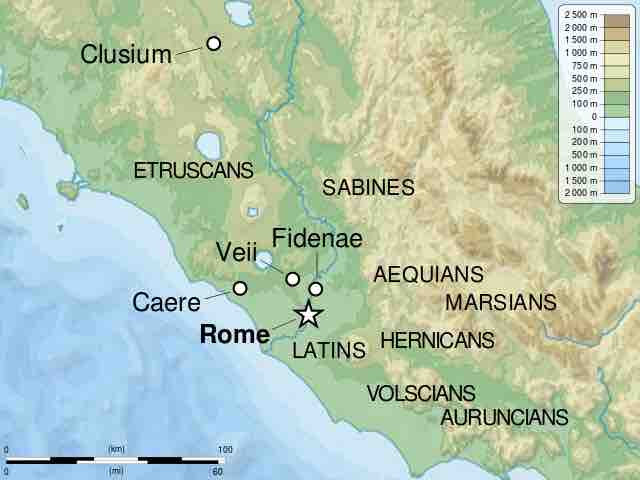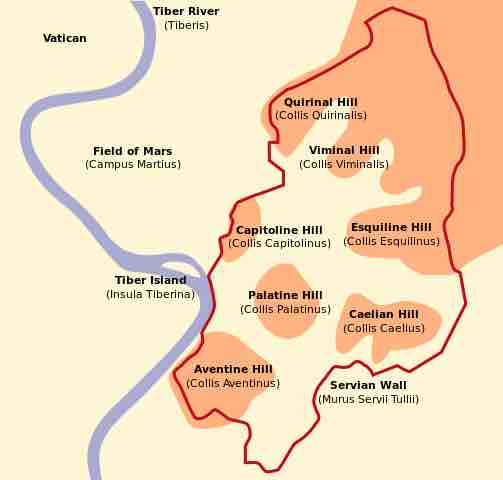Foundation Myths
The Romans relied on two sets of these to explain their origins: the first story tells the tale of Romulus and Remus, while the second tells that of Aeneas and the Trojans, who survived the sack of Troy by the Greeks. Oddly, both stories relate the founding of Rome and the origins of its people to brutal murders. Romulus killed his twin brother, Remus, in a fit of rage, and Aeneas slaughtered his rival Turnus in combat. Roman historians used these mythical episodes as the reason for Rome's own bloody history and periods of civil war. While foundation myths are the most common vehicle through which we learn about the origins of Rome and the Roman people, the actual history is often overlooked.
The Historical Record
Archaeological evidence shows that the area that eventually became Rome has been inhabited continuously for the past 14,000 years. The historical record provides evidence of habitation on and fortification of the Palatine Hill during the eighth century BCE, which supports the date of April 21, 753 BCE as the date that ancient historians applied to the founding of Rome in association with a festival to Pales, the goddess of shepherds. Given the importance of agriculture to pre-Roman tribes, as well as most ancestors of civilization, it is logical that the Romans would link the celebration of their founding as a city to an agrarian goddess.
Romulus, whose name is believed to be the namesake of Rome, is credited for its founding. He is also credited with establishing the period of monarchical rule. Six kings ruled after him until 509 BCE, when the people rebelled against the last king, Tarquinius Superbus, and established the Republic. Throughout its history, the people-including plebeians, patricians, and senators--were wary of giving one person too much power and feared the tyranny of a king.
Pre-Roman Tribes
The villages that would eventually merge to become Rome were descended from Italic tribes. Italic tribes spread throughout the present-day countries of Italy and Sicily. Archaeological evidence and ancient writings provide very little information on how--or whether--pre-Roman tribes across the Italian peninsula interacted. What is known is that they all belonged to the Indo-European linguistic family, which gave rise to the Romance (Latin-derived) and Germanic languages. What follows is a brief history of the two of the eight main tribes that contributed to the founding of Rome: the Latins and the Sabines. Information about a third culture, the Etruscans, can be found in Chapter 7.
The Latins had inhabited the Alban Hills since the second millennium BCE. According to archaeological remains, the Latins were primarily farmers and pastoralists. Approximately at the end of the first millennium BCE, they moved into the valleys and along the Tiber River, which provided better land for agriculture. Although divided from an early stage into communities which mutated into several independent, and often warring, city-states, the Latins and their neighbors maintained close culturo-religious relations until they were definitively united politically under Rome. These included common festivals and religious sanctuaries.
The Latins appear to have become culturally differentiated from the surrounding Italic tribes from about 1000 BCE onward. From this time, the Latins' material culture shares more in common with the Iron Age Villanovan culture found in Etruria and the Po valley than with their former Osco-Umbrian neighbors.The Latins thus shared the broadly same material culture as the Etruscans. However, archaeologists have discerned among the Latins a variant of Villanovan, dubbed the Latial culture. The most distinctive feature of Latial culture were cinerary urns in the shape of huts. They represent the typical single-roomed abodes of area peasants, which were made from simple, readily available materials: wattle-and-daub walls and straw roofs supported by wooden posts. The huts remained the main form of Latin housing until the mid-seventh century BCE.
Cinerary Urn
This Villanovan urn likely replicates the form that pre-Roman Latin huts assumed before the mid-seventh century BCE.
The Sabines originally inhabited the Apennines and eventually relocated to Latium before the founding of Rome. The Sabines divided into two populations just after the founding of Rome, which is described by Roman legend. The division, however it came about, is not legendary. The population closer to Rome transplanted itself to the new city and united with the pre-existing citizenry, beginning a new heritage that descended from the Sabines but was also Latinized. The second population remained a mountain tribal state, coming finally to war against Rome for its independence along with all the other Italic tribes. After losing, it became assimilated into the Roman Republic.
There is little record of the Sabine language. However, there are some glosses by ancient commentators, and one or two inscriptions have been tentatively identified as Sabine. There are also personal names in use on Latin inscriptions from Sabine territories, but these are given in Latin form. Existing scholarship classifies Sabine as a member of the Umbrian group of Italic languages and identifies approximately 100 words that are either likely Sabine or that possess Sabine origin.

Pre-Roman tribes
Map showing the locations of the tribes who settled Rome.
The Seven Hills
Before Rome was founded as a city, its people existed in separate settlements atop its famous Seven Hills: the Aventine Hill, the Caelian Hill, the Capitoline Hill, the Esquiline Hill, the Palatine Hill, the Quirinal Hill, and the Viminal Hill. Over time, each tribe either united with or was absorbed into the Roman culture.
Recent studies suggest that the Quirinal Hill was very important to the ancient Romans and their immediate ancestors. It was here that the Sabines originally resided. Its three peaks were united with the three peaks of the Esquiline, as well as villages on the Caelian Hill and Suburra. Tombs from the eighth to the seventh century BCE that confirm a likely presence of a Sabine settlement area have been discovered on the Quirinal Hill. Some authors consider it possible that the cult of the Capitoline Triad (Jove, Minerva, Juno) could have been celebrated here well before it became associated with the Capitoline Hill. The sanctuary of Flora, an Osco-Sabine goddess, was also at this location. Titus Livius (better known as Livy) writes that the Quirinal Hill, along with the Viminal Hill, became part of Rome in the sixth century BCE.
According to Livy, the Palatine Hill, located at the center of the ancient city, became the home of the original Romans after the Sabines and the Albans moved into Roman lowlands. Due to its historical and legendary significance, the Palatine Hill became the home of many Roman elites during the Republic and emperors during the Empire. It was also the site of a temple to Apollo built by Emperor Augustus and the pastoral (and possibly pre-Roman) festival of Lupercalia, which was observed on February 13 through 15 to avert evil spirits, purify the city, and release health and fertility.
Festivals for the Septimontium (literally "of the Seven Hills") on December 11 were previously considered to be related to the foundation of Rome. However, because April 21 is the agreed-upon date of the city's founding, it has recently been argued that Septimontium celebrated the first federations among the Seven Hills. A similar federation was celebrated by the Latins at Cave or Monte Cavo.

Seven Hills of Rome
A schematic map of Rome showing the Seven Hills.